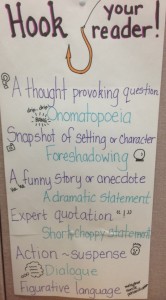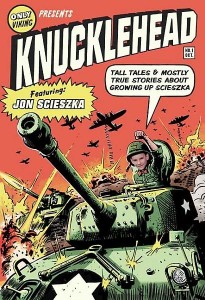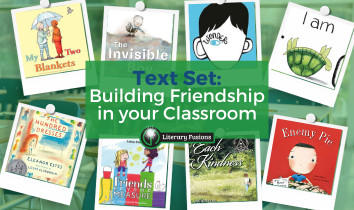Sherry and I recently attended and presented at TCTELA in Houston. While there, we were most excited about hearing Jeff Anderson and Mark Overmeyer present sessions on revision and troubleshooting a Writers’ Workshop. When Sherry and I got home later that night we busily discussed all the things we were thinking about from the conference. That’s when I looked up Mark Overmeyer’s blog. Why had I never done this before? While browsing I saw him mention one of my all time favorite authors – Jon Scieszka. He was talking about Scieszka’s memoir. How did I miss this book?? I thought I was doing a fine job of stalking Scieszka (see picture where we stalked him at the Austin Book Festival in 2012!), but apparently I has missed this very important publication. Immediately, Sherry and I fought over who would read and review the book. All I have to say is, I’m writing this review!
I miss this book?? I thought I was doing a fine job of stalking Scieszka (see picture where we stalked him at the Austin Book Festival in 2012!), but apparently I has missed this very important publication. Immediately, Sherry and I fought over who would read and review the book. All I have to say is, I’m writing this review!
Why I Finished It:
This one was virtually impossible to put down. I smiled the entire time and found myself missing meals in order to keep reading. Honestly, I was a little sad when it ended. This book is comprised of short (2 to 3 pages) stories about Jon’s life. There are photographs that illustrate the moments and titles that clue you in to what you are about to read. Each moment is personable, engaging, and witty.
Who I Would Give It To:
Amazon suggests this for grades 3-5. I would definitely recommend it for those ages, but it does mention a few bad words here and there (nothing drastic, but they’re there). I would say grades 4-8, although, I did allow my second grader to read it. He thought it was hilarious. This book is also necessary for all teachers who teach personal narrative!
Integration Ideas:
Writers’ Workshop – Personal Narrative (Memoir)
As a teacher, we’re always hunting for perfect examples of personal narratives. Something real that happened to the author, something focused, something with great writing. Here it is! This book is really 38 personal narratives. As a teacher, choose one to read aloud for enjoyment. During writing time, reread the story have the students “Read Like a Writer.” Explain that you want them to think of it as a personal narrative. This is a true event that happened to Jon Scieszka. As we read this story, I want you to think about how focused his story is and the details he included. After reading, as a class, create a chart that explains what the focus of the writing was and what details he included. Why were those details included? Did they enhance the story? How?
Students should write their own personal narratives. Ask the students where Jon Scieszka got his ideas. We want students to realize that we all have great stories. He had so many, he had to write 38! The stories come from his own life, small events that happened. Allow students time to brainstorm their own ideas of things that happened in their own life. Then they can begin drafting. As students continue to work on the drafts, continue to use this book as a mentor text.
Use the text to explain how Jon adds in specific details. “This is me in the classic witch outfit. Pointy black hat, black cape – done. You had to be talked into this outfit before you were old enough to realize that witches were girls.” (p 43) Why did he choose to describe this costume this way – with just two words? Was this effective? What if he had spent a ton of time and words describing this one costume?
As students continue to add detail to their writing that is important for the story, you can also begin to discuss word choice. “After the talk was over, we swarmed around the hospital room, looking for any kind of cool stuff.” (p 47). Why did the author use the word swarmed? Students should cue in to the fact that there are a lot of students who are swarming like bees around the place, huddled together and moving as one. The word “swarm” perfectly paints that picture. Insert other words in the sentence to have students realize how it doesn’t have the same effect or picture. Then students can go into their own piece and work on their own word choice.
Writers’ Workshop – Leads
Leads are what authors use to hook the reader. Sometimes students get stuck on a particular lead and abuse it in their own writing. You probably have the student that begins EVERY PAPER with a question. We need to provide students with a wide range of options and then we need to encourage them to play with those options. I like to create an ongoing anchor chart with students, or an anchor chart that we will continue to grow throughout the year – “Effective Hooks” is usually what we call it. What are ways authors hook readers? Every time we read a text, we will decide what tool the author used to hook the reader. We will spend some time discussing if it was effective or not. Then we’ll add the idea to the chart (was it suspenseful, humorous, descriptive, etc.). After creating the chart, we will decide what type of writing needs which type of hook. If I’m about to write a very serious expository paper, I wouldn’t want my hook to be humorous! Students need to know that the hook should set the tone for the paper.
“Effective Hooks” is usually what we call it. What are ways authors hook readers? Every time we read a text, we will decide what tool the author used to hook the reader. We will spend some time discussing if it was effective or not. Then we’ll add the idea to the chart (was it suspenseful, humorous, descriptive, etc.). After creating the chart, we will decide what type of writing needs which type of hook. If I’m about to write a very serious expository paper, I wouldn’t want my hook to be humorous! Students need to know that the hook should set the tone for the paper.
Obviously, Scieszka’s book is witty. So the leads are mostly humorous. Sometimes they are foreshadowing and even setting up the topic. Here are a few I would use as mentor text leads:
- “I learned how to cook because I like to stir oatmeal more than I like to pick up dog poop.” (p 20).
- “You know that little bone in the front part of your shoulder? The Collarbone? Did you know you can break that bone with just seven pounds of pressure?” (p 41)
- “Since my mom was a nurse and my dad was an elementary-school principal, we got to do some pretty weird things that we just thought were normal.” (p 46)
Remember, that with each one, you want to ask the students if the lead was effective or ineffective and why or why not. What type of tone is it setting for the rest of the narrative?
Links:
- Visit Jon Scieszka’s website for many reasons, but a main one is that it will tell you how to say his name! Make sure your volume is up.
- Ideas from Reading Rockets in using this book K-8!







Leave a Reply